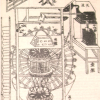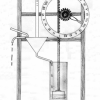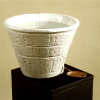Water clocks
Commentary
The basic requirement for these earlier timekeepers was a force that operated constantly and continuously over long periods of time. Although limited use was made of candle clocks, the obviously supply of constant force was gravity.
The most ancient and successful gravity-fed timekeeping devices were water clocks. Water passing through a restricted opening at a relatively constant rate provided an indication of elapsed time.
The simplest form was the outflow water clock, already known in ancient Egypt, c. 1500 BC (Image 1), consisted of a vessel with a narrow outflow spot made to discharge water slowly and at a steady pace. Observers could tell the time by the lines marked on the interior of the vessel.
One basic problem with the outflow water clock was that, as the water level dropped, so did the water pressure and the rate of flow. The inflow water clock was developed to solve this problem. This device consists, in essence, of two vessels. The upper vessel is constantly filled with water faster than the water drains into the lower vessel. The excess water drains away, keeping the water level in the upper vessel -- and the rate at which it drains into the lower vessel -- constant. The time can therefore be measured by the level of the water in the lower vessel.
An additional advantage of this arrangement is that a float in the lower vessel can be used to drive a geared mechanism which displays the time on a dial. We shall return to this innovation below.
During the European middle ages, highly elaborate water clocks were developed in China and the Islamic world. Image 2 depicts a more complex device at the court in Paris ca 1250.
One fundamental difficulty with water clocks was that the rate at which water drained from a basin is not in fact constant: it varies with temperature and humidity. An additional problem is climatic: in very hot and dry climates, water evaporates quickly, while in cold climates the water can freeze. The latter problem limited the utility of water clocks in northern Europe in particular.
Commentary: Howard Hotson (May 2024)





